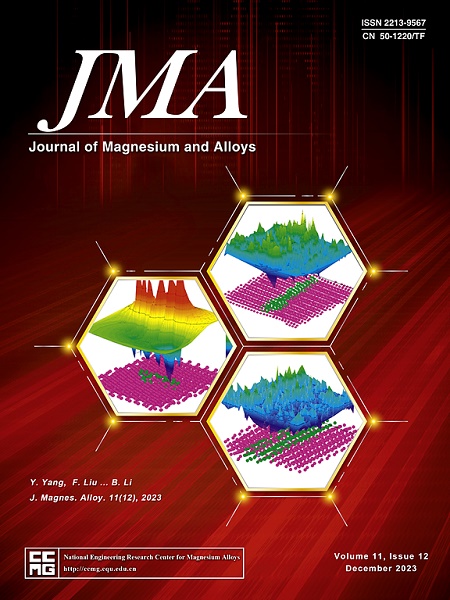退火对镁铝复合板微观结构和机械各向异性的影响
IF 15.8
1区 材料科学
Q1 METALLURGY & METALLURGICAL ENGINEERING
引用次数: 0
摘要
本文通过不同的退火工艺研究了再结晶、晶粒长大和纹理演变对镁铝复合板成型性和各向异性的影响。结果表明,轧制的镁/铝复合板在轧制方向(RD)和横向方向(TD)上表现出明显的各向异性,成型性较差,这是基体质地和晶粒特征协同作用的结果。退火激活的再结晶可消除轧制形成的局部剪切带、硬化和其他缺陷,从而软化结构并改善板材的成型性。再结晶行为的发生还使镁基体中与 TD 分布平行的双峰纹理转变为 RD-TD 表面分散分布,从而削弱了强变形纹理。通过计算各滑移体系的施密特因子(SF)来评估材料在某一方向上的滑移体系启动概率(变形难度)。结果表明,退火处理后,RD 和 TD 方向基体滑移的平均 SF 值增加,这使得滑移体系更容易启动。拉伸试验结果表明,当退火温度为 300 ℃ 时,复合板的成型性最好。此时,极限拉伸强度(UTS)和屈服强度(YS)较小,伸长率(EL)较大,力学性能的各向异性最弱。此外,复合板的退火会导致断裂机理从脆性断裂转变为韧性-脆性混合断裂。总之,退火处理能有效改善镁铝复合板的成型性并削弱其各向异性。本文章由计算机程序翻译,如有差异,请以英文原文为准。
Effect of annealing on the microstructure and mechanical anisotropy of Mg/Al composite plate
In this paper, the effects of recrystallization, grain growth and texture evolution on the formability and anisotropy of Mg/Al composite plates were studied by different annealing processes. The results show that the rolled Mg/Al composite plate exhibits obvious anisotropy and poor formability in the rolling directions (RD) and transverse directions (TD), which is the result of the synergistic effect of matrix texture and grain characteristics. Annealing-activated recrystallization can eliminate local shear bands, hardening and other defects formed by rolling, thereby softening the structure and improving the formability of the sheet. The occurrence of recrystallization behavior also makes the bimodal texture parallel to the TD distribution in the Mg matrix transform into the RD-TD surface dispersion distribution, which weakens the strong deformation texture. The Schmidt factor (SF) of each slip system is calculated to evaluate the slip system start-up probability (deformation difficulty) of the material in a certain direction. The results show that the average SF values of matrix slip in RD and TD directions increase after annealing treatment, which makes the slip system easier to start. The tensile test results show that the formability of the composite plate is the best when the annealing temperature is 300 °C. At this time, the ultimate tensile strength (UTS) and yield strength (YS) are small, the elongation (EL) is large and the anisotropy of mechanical properties is the weakest. In addition, the annealing of the composite plate leads to the transformation of the fracture mechanism from brittle fracture to ductile-brittle mixed fracture. In summary, annealing treatment can effectively improve the formability and weaken the anisotropy of Mg/Al composite plates.
求助全文
通过发布文献求助,成功后即可免费获取论文全文。
去求助
来源期刊

Journal of Magnesium and Alloys
Engineering-Mechanics of Materials
CiteScore
20.20
自引率
14.80%
发文量
52
审稿时长
59 days
期刊介绍:
The Journal of Magnesium and Alloys serves as a global platform for both theoretical and experimental studies in magnesium science and engineering. It welcomes submissions investigating various scientific and engineering factors impacting the metallurgy, processing, microstructure, properties, and applications of magnesium and alloys. The journal covers all aspects of magnesium and alloy research, including raw materials, alloy casting, extrusion and deformation, corrosion and surface treatment, joining and machining, simulation and modeling, microstructure evolution and mechanical properties, new alloy development, magnesium-based composites, bio-materials and energy materials, applications, and recycling.
 求助内容:
求助内容: 应助结果提醒方式:
应助结果提醒方式:


